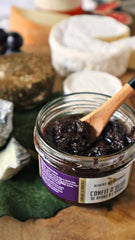A delicious cheese platter with French soft and hard cheeses. Simple and delicious, just like in France.
However, there are a few small rules to ensure you have a delicious cheese experience!
Our 6 tips for the perfect French cheese platter!
1. Choose cheeses for the cheese platter. It's all about the mix!
Make sure to buy a mix of creamy, tart, hard and mild cheeses.
The best thing to do is to go directly to the farm or to your cheesemonger. Get advice and taste whenever possible. The taste and consistency depend on the degree of ripeness but also on the temperature.A mix of our favorite cheeses for the French cheese platter are:
- Creamy & mild : Camembert, Brie
- Creamy & Intense : Roquefort, Banon
- Mild & aromatic: fresh goat cheese with savory (Sarriette) or Rocamadou
- Hard & intense: matured Gruyere or Comté
- Hard & mild: Ossau-Iraty, Emmental
- Hard & aromatic: Tomme with truffle, Morbier
2. Arrange the cheese platter - everything must be in order!
On the platter, it looks nice if the cheese is arranged clockwise (or in another order) from mild to tart.
This means that the tasting can be systematically started with the milder cheeses. Since some cheeses have a very intense taste, it is good to eat them at the end of the tasting. Otherwise, they could mask the taste of the milder cheeses.

3. Cheese and temperature. An important detail.
Cheese does not develop its aroma in the refrigerator. The texture of the cheese is also not ideal for the cheese platter when it is freshly chilled.
Therefore, you should take the cheese out of the fridge at least 15 minutes before serving.
Cheeses such as Camembert, Brie and Banon only become creamy and spreadable at room temperature.
Be careful in summer or at high room temperatures. The cheese can sweat (hard cheese) or become very runny (Camembert, Banon...). It should therefore be eaten quickly so that it does not run off the cheese plate...
4. The right side dishes for your cheese platter
Cheese goes very well with sweet foods such as honey, confit and fruit.
For our cheese platter we chose our olive confit with candied orange . It goes really well with hard cheeses like Gruyère, Comté and especially with Ossau-Iraty. Our olive ginger confit would also go really well. If you prefer something more classic , onion confit or a great fig jam are always a good choice.
A classic on every French cheese platter is honey. Our rosemary honey goes wonderfully with our fresh goat cheese from Provence.
Add fresh pears, figs and grapes cut into thin slices. Or whatever the season has to offer. Walnuts are also great (delicious with Roquefort!) and dried fruit such as apricots or figs.

And of course, good bread is a must. Fresh baguette is best. A good baguette is crispy on the outside and soft on the inside. If it is no longer fresh, simply moisten it with water and put it in the oven for 5 minutes.
If your baguette is no longer quite fresh, simply moisten it slightly with water and put it in the oven for 5 minutes.
5. Which wine goes with cheese? The big mistake!
Of course, a good wine is a must with a French cheese platter!
It is not true that only red wine goes well with cheese. White wine also goes well with cheese! Some sommeliers even believe that white wine goes better with cheese than red wine.
Ultimately, your personal taste decides.
We recommend the wines from the AOP Ventoux growing region from the Domaine des Hauts Traversiers to accompany our cheese platter inspired by Provence.
For red wine lovers we recommend the red wine "Foudonne" . An intense dry red wine that smells of thyme & liquorice and has a slightly woody, fresh aroma.
Or the white wine "Espuol" from the same winery. A dry white wine with a slightly woody note. It smells of white peaches and candied chestnuts.
Both wines are elaborately produced in small quantities and matured in barrique barrels. They go well with cheese but also with meat and fish, especially in the cold season.
6. Cheese as dessert or before dinner?
In fact, there is sometimes confusion about whether cheese should be served before or after a meal.
In France there are two ways to offer cheese to your guests or in a restaurant.
The cheese is either served as an elaborate cheese platter as a snack or even as a main course. For example, in wine bars or when you invite your friends and family to an aperitif dinatoire. A large cheese platter is often placed on the table. Everyone shares the delicacies to enjoy with good wine. In our article about the ritual of the aperitif you can find out more about how the French celebrate the aperitif.
The other option is to serve cheese as a dessert. In restaurants, cheese is often found in the dessert category. However, cheese is also often served as a second dessert, or before the actual dessert.
Cheese is always a pleasure. Whether as a dessert or as a starter.
Now you know everything you need to know to create a wonderful cheese platter. With good products and in the company of your friends and family, this is guaranteed to be a highlight for your holiday table or whenever you fancy a touch of France!
In the shop you will find the basis for your next cheese platter. Delicious confits, honey, jams and wine will be sent directly to your home by post!
Bon appetite !








Leave a comment (all fields required)